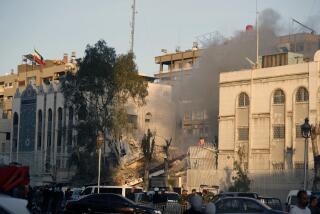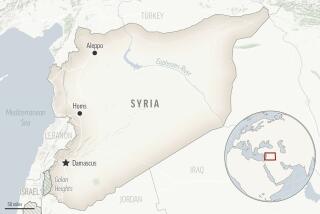Fears mount after militants seize Syria’s Palmyra antiquities site
Islamic State extremists captured the ancient Syrian town of Palmyra on Wednesday, drawing alarm worldwide about the fate of one of the world’s most spectacular architectural treasures.
The apparent capture of the historic city from government forces came days after the extremists took control of the strategic city of Ramadi in neighboring Iraq.
Maamoun Abdulkarim, Syria’s general director of antiquities and museums, said Palmyra’s town museum had suffered “minor damages” during the onslaught.
“The city is now totally controlled by gunmen and its destiny is dark and dim,” Abdulkarim told the Associated Press. “We are in a state of anticipation and fear” about what will happen to “the archaeological site and the remaining artifacts in the museum.”
Many Palmyra residents were fleeing the town Thursday toward the city of Homs and the capital, Damascus, Talal Barazi, the governor of the central province of Homs, told the AP. The Syrian army is now outside the town, from where it is targeting Islamic State reinforcements, he said.
“We have not received any news about [the archaeological site’s] destruction,” Barazi said. “We hope that there will be no massacres in the city or damage to the ruins.”
The United States had expressed concern about the fate of Palmyra and the ancient ruins Wednesday.
“We are deeply concerned by reports of [Islamic State’s] attacks on the Syrian city which holds the ruins of Palmyra,” said Marie Harf, a State Department spokeswoman. “There are different reports about exactly what’s happening there, so it’s hard for us to nail down ... exactly what’s happening on the ground. But we know that this is a city that has been caught in the crossfire for some time, certainly.”
“We’ll keep seeing what’s happening on the ground, but this is the reason we’re trying to push back [Islamic State] out of Iraq and to try and help the Syrian opposition push back [Islamic State] in Syria,” Harf said.
Islamic State fighters, some using tunnels, had entered the city of Tadmur, which adjoins the ruins, Abdulkarim, the director of antiquities, said Wednesday. Syrian army units, he said, were fighting to stop the extremists from entering the sprawling archaeological site, known for its majestic colonnades from the Roman era, stone roads and ancient burial site.
“There are solitary elements with light weapons who infiltrated some areas, they are trying to spread into the city,” Abdulkarim said in a telephone interview. “The large numbers have yet to come in, and we are asking for the international community to stop those people.”
On Wednesday, he had called for U.S.-led coalition airstrikes on Islamic State convoys approaching the archaeological site, a stunning collection of ruins that rise from the desert in what was a crucial trade hub, caravan stop and prosperous metropolis in ancient times. Before the Syrian war, Palmyra was a major tourist attraction, drawing visitors from across the globe to the isolated site about 130 miles northeast of Damascus, the capital.
Syria and Iraq have long been crossroads of civilization and are home to many significant historic sites and ancient ruins.
Irina Bokova, the director-general of the United Nations Educational, Scientific and Cultural Organization, said she was “deeply concerned” about reports of armed conflict near Palmyra, which is a UNESCO World Heritage site.
“The fighting is putting at risk one of the most significant sites in the Middle East, and its civilian population,” Bokova said in a statement Wednesday, calling for “an immediate cessation of hostilities” at the site.
The army is thinly stretched, fighting rebel forces on many fronts. Palmyra is in a strategic zone of Homs province, near gas fields and on the road to the Islamic State stronghold of Dair Alzour and Iraq.
Islamic State, an Al Qaeda breakaway faction that adheres to a fundamentalist interpretation of Islam, has made a point of destroying pre-Islamic ruins, statues and relics, labeling them as idolatrous -- and reveling in the shock value and outrage caused worldwide by the wanton destruction. The group has posted video online of its adherents taking sledgehammers to fabled sites, such as Iraq’s ancient cities of Hatra and Nimrud, just as it has disseminated images of beheadings and mass killings.
Islamic State and other Syrian rebel factions are also implicated in the lucrative black-market antiquities trade, authorities say. The clandestine business has boomed with the lawlessness that has taken hold in much of the country since the war broke out in 2011.
As rebels advanced on many fronts, Syrian authorities have moved many statues and other priceless objects to safety, including items from Palmyra. But not everything can be taken away.
“We took exceptional measures and moved hundreds of statues, but there are some things that cannot be moved,” said Abdulkarim, who has become a worldwide advocate for saving Syria’s cultural heritage. “The tragedy is how will we move the temples, the graveyards?”
A U.S.-led coalition has been waging an air war against Islamic State positions in Syria for eight months, but officials in Washington say they do not coordinate with the government of President Bashar Assad. The Obama administration has called for the Syrian leader to step down and has aided opposition elements fighting to topple his government. Whether the U.S.-led coalition would cooperate with Assad’s forces in a bid to save Palmyra remained unclear.
Bulos is a special correspondent.
Follow @mcdneville on Twitter for news out of the Middle East.
More to Read
Start your day right
Sign up for Essential California for news, features and recommendations from the L.A. Times and beyond in your inbox six days a week.
You may occasionally receive promotional content from the Los Angeles Times.






